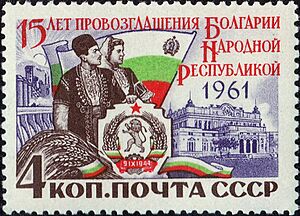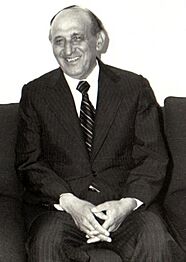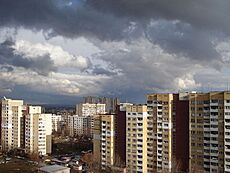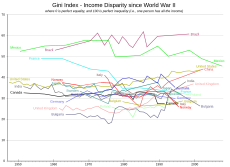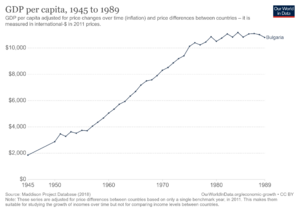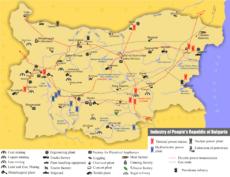People's Republic of Bulgaria facts for kids
Quick facts for kids
People's Republic of Bulgaria
Народна република България
|
|||||||||
|---|---|---|---|---|---|---|---|---|---|
| 1946–1990 | |||||||||
|
|
|||||||||
|
Anthem:
Maritsa Rushes (1946–1947)
Шуми Марица (Bulgarian) Shumi Maritsa (transliteration) Our Republic, Hail! (1947–1951)
Републико наша, здравей! (Bulgarian) Republiko nasha, zdravey! (transliteration) Dear Bulgaria, Land of Heroes (1951–1964)
Българийо мила, земя на герои (Bulgarian) Bŭlgariyo mila, zemya na geroi (transliteration) Dear Motherland (from 1964) Мила Родино (Bulgarian) Mila Rodino (transliteration)
|
|||||||||
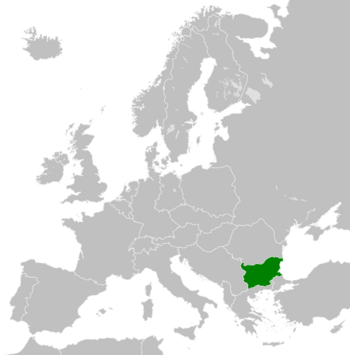
The People's Republic of Bulgaria until 1989
|
|||||||||
| Status | Warsaw Pact and Comecon member | ||||||||
| Capital and largest city
|
Sofia 42°41′N 23°19′E / 42.683°N 23.317°E |
||||||||
| Official languages | Bulgarian | ||||||||
| Official script | Cyrillic | ||||||||
| Religion | Secular state (de jure) State atheism (de facto) Bulgarian Orthodoxy (majority dominant) |
||||||||
| Demonym(s) | Bulgarian | ||||||||
| Government | 1946–1956: Unitary Marxist–Leninist one-party socialist republic under a Stalinist dictatorship 1956–1989: Unitary Marxist–Leninist one-party socialist republic 1989–1990: Unitary multi-party parliamentary republic |
||||||||
| General Secretary | |||||||||
|
• 1946–1949
|
Georgi Dimitrov | ||||||||
|
• 1949–1954
|
Vulko Chervenkov | ||||||||
|
• 1954–1989
|
Todor Zhivkov | ||||||||
| Head of state | |||||||||
|
• 1946–1947 (first)
|
Vasil Kolarov | ||||||||
|
• 1990 (last)
|
Zhelyu Zhelev | ||||||||
| Head of government | |||||||||
|
• 1946–1949 (first)
|
Georgi Dimitrov | ||||||||
|
• 1990 (last)
|
Andrey Lukanov | ||||||||
| Legislature | National Assembly State Council (1971–1990) |
||||||||
| Historical era | Cold War | ||||||||
| 15 September 1946 | |||||||||
|
• Zhivkov Constitution
|
18 May 1971 | ||||||||
| 15 November 1990 | |||||||||
|
• 1991 Constitution
|
12 July 1991 | ||||||||
| Area | |||||||||
|
• Total
|
110,994 km2 (42,855 sq mi) | ||||||||
|
• Water (%)
|
0.3 | ||||||||
| Population | |||||||||
|
• 1946
|
7,029,349 | ||||||||
|
• 1989
|
8,987,000 | ||||||||
| HDI (1989) | 0.918 very high |
||||||||
| Currency | Bulgarian lev | ||||||||
| Time zone | UTC+2 (EET) | ||||||||
|
• Summer (DST)
|
UTC+3 (EEST) | ||||||||
| Driving side | right | ||||||||
| Calling code | +359 | ||||||||
| ISO 3166 code | BG | ||||||||
|
|||||||||
The People's Republic of Bulgaria (often called PRB) was the official name for Bulgaria from 1946 to 1990. During this time, Bulgaria was a socialist state, which means the government had strong control over the country and its economy. The Bulgarian Communist Party (BCP) was the main ruling party.
Bulgaria was a close friend and ally of the Soviet Union during the Cold War. It was so close that some people even called it the "16th Soviet Republic." Bulgaria was also part of two important groups: Comecon, which focused on economic cooperation, and the Warsaw Pact, a military alliance.
The PRB began after a big change in 1944. A group called the Bulgarian resistance took over from the old government, ending Bulgaria's alliance with the Axis powers in World War II. This led to the creation of the People's Republic in 1946.
The BCP followed the Soviet Union's ideas. Over about ten years, Bulgaria changed from a country mostly based on farming to one with a lot of factories and industries. After the mid-1950s, the government became a bit more open under Todor Zhivkov. Bulgaria built new roads and power systems. By 1960, manufacturing was very important. Bulgaria became a big exporter of things like household goods and even early computer technology. This earned it the nickname "Silicon Valley of the Eastern Bloc."
In 1989, after many years, political changes started. Todor Zhivkov, who had led the party since 1954, was removed from his position. In 1990, the BCP changed its name to the Bulgarian Socialist Party (BSP) and decided to support a more democratic system. After the BSP won the first open elections since 1931, the country's name changed to the Republic of Bulgaria.
The People's Republic of Bulgaria had the same borders as modern-day Bulgaria. It was next to the Black Sea in the east, Romania in the north, Yugoslavia in the west, and Greece and Turkey in the south. The first elected president, Zhelyu Zhelev, took office on August 1, 1990. On November 15, 1990, the country was officially renamed the Republic of Bulgaria.
Contents
Bulgaria's History
On March 1, 1941, the Kingdom of Bulgaria joined the Tripartite Pact, becoming part of the Axis Powers. After Germany invaded Yugoslavia and Greece, Bulgaria took control of some parts of those countries. In 1942, a group called the Fatherland Front was formed to resist the Axis powers. It included Communists, Socialists, and farmers' groups.
The Communist Takeover
In 1944, when the Red Army (Soviet army) entered Romania, Bulgaria left the Axis powers and said it would stay neutral. But on September 5, the Soviet Union declared war on Bulgaria. Three days later, the Red Army entered northern Bulgaria.
On September 9, communist fighters launched a takeover. This ended the rule of the Bulgarian monarchy. A new government, led by the Fatherland Front and the Bulgarian Communist Party, took power.
Early Years and Changes
After the takeover, the Fatherland Front formed a government with other groups. Bulgaria was allowed to keep Southern Dobruja but gave up claims to land in Greece and Yugoslavia. Many Bulgarians who had settled in Western Thrace were asked to leave.
At first, the Communists seemed to play a smaller role in the new government. However, a Communist-controlled police force was created, which made it difficult for other political parties.
In February 1945, many former officials, including Prince Kiril, were arrested. Many were later removed from power. The new government also arrested people who had worked with the Nazis. Thousands of people faced serious consequences, including long prison sentences. The government also made changes to the army.
In November 1945, Georgi Dimitrov, a Communist Party leader, returned to Bulgaria. Elections held a few weeks later gave the Fatherland Front a large win.
Becoming a People's Republic
In September 1946, the monarchy was ended after a public vote, with 95.6 percent voting for a republic. The young king, Simeon II, went into exile. The Communists then openly took power, and Bulgaria was officially called a People's Republic. Vasil Kolarov became president.
Over the next year, the Communists gained even more control. In October 1946, elections for a new assembly gave the Communists a majority. A month later, Dimitrov became prime minister.
Other political parties either joined the Communists or were shut down. In December 1947, a new constitution, called the "Dimitrov Constitution," was approved. It was based on the Soviet constitution. By 1948, the Social Democrats merged with the Communists, and the Agrarian Union became a loyal partner.
During 1948–1949, religious groups like the Orthodox, Muslim, Protestant, and Roman Catholic organizations faced restrictions or were banned. The Bulgarian Orthodox Church continued to exist but lost much of its influence.
Dimitrov died in 1949. For a short time, Bulgaria was led by a group of leaders. Vulko Chervenkov led the Communist Party, and Vasil Kolarov was prime minister. When Kolarov died, Chervenkov became prime minister too. Chervenkov started a fast process of building industries and collecting farms, similar to what Stalin did in the Soviet Union.
After Stalin's death in 1953, changes happened in Bulgaria. In 1954, Chervenkov shared leadership and gave his party leader position to Todor Zhivkov. The government also released many political prisoners and focused on making life better for people instead of just building more industries. Chervenkov remained prime minister until April 1956.
Changes in the 1970s and 1980s
In 1971, a new constitution, called the "Zhivkovskata" Constitution, was created. It stated that the Communist Party was the main ruling force in society. Zhivkov became the Head of State, and Stanko Todorov became Prime Minister.
Bulgaria signed the Helsinki Accords in 1975. This agreement promised to protect human rights and freedoms, like freedom of movement and education. However, later events involving Bulgarian Turks in the 1980s went against these promises.
In 1978, a writer named Georgi Markov died under mysterious circumstances in London. It was later confirmed by documents that the Bulgarian secret service was involved.
The Bulgarian People's Army supported the Soviet Union during the Soviet–Afghan War from 1982 to 1989.
End of the People's Republic
By the 1980s, the government was becoming less flexible. Some social and cultural changes were led by Lyudmila Zhivkova, Todor Zhivkov's daughter. She was interested in Eastern religions, which was unusual for the Communist Party. She died in 1981.
In the winter of 1984, a controversial campaign began against the ethnic Turkish minority. They were not allowed to speak Turkish and were forced to change their names to Bulgarian ones. This caused problems for Bulgaria's trade with Western countries. The 1989 expulsion of Turks from Bulgaria also led to a big drop in farming production in the southern areas because many workers left.
In the late 1980s, the Communist leaders were no longer able to stop the demands for change. People started protesting for political reforms. More moderate leaders in the Communist Party removed Zhivkov from his position on November 10, 1989, and replaced him with Petar Mladenov.
This change gave the Communist Party a short break. Mladenov promised to open up the government and said he supported multi-party elections. Protests continued across the country, leading Mladenov to announce that the Communist Party would give up its complete control over the political system. On January 15, 1990, the National Assembly officially removed the Communist Party's "leading role" from the law.
In June 1990, the first multi-party elections since 1939 were held. Finally, on November 15, 1990, the Grand National Assembly voted to change the country's name to the Republic of Bulgaria and removed the Communist state symbol from the national flag.
A 2009 survey showed that only 11% of Bulgarians felt that ordinary people benefited from the changes in 1989. However, a 2019 survey found that 55% of Bulgarians approved of the shift to a market economy and 54% approved of the shift to multi-party democracy.
Government and Politics
The constitution of the People's Republic of Bulgaria was changed two times. The Zhivkov Constitution lasted the longest. It stated that Bulgaria was a socialist state led by working people, and the Bulgarian Communist Party was the main force in society and politics. The BCP had a large network of officials at every level of government.
The PRB was a one-party state, meaning only one political party was truly in charge. Local governments were run by People's Committees. Their job was to carry out the Party's decisions and listen to what people wanted. In the late 1980s, the BCP had about 1,000,000 members, which was more than 10% of the population.
Military Power
In 1946, the military quickly adopted Soviet military ideas and organization. Bulgaria received many weapons from the Soviet Union and eventually started making its own military vehicles. By 1988, the Bulgarian People's Army had 152,000 soldiers. They served in four main groups: Land Forces, Navy, Air and Air Defense Forces, and Missile Forces.
The army had 3,000 tanks, 2,000 armored vehicles, and 2,500 large artillery systems. They also had over 500 combat aircraft, 33 combat ships, and many missile launchers.
Economy and Trade
| 1945 | 1946 | 1947 | 1948 (Jan. to May) | |
|---|---|---|---|---|
| Soviet Union | 95.2% | 66% | 51.9% | 41.5% |
| Eastern Europe | 2.3% | 17% | 33.7% | 34.2% |
| Britain | – | 0.5% | 0.1% | 0.3% |
| United States | – | 5.2% | 6.0% | 0.2% |
| Total | 12,397,00 | 14,942,000 | 24,532,740 | 12,127,909 |
| 1945 | 1946 | 1947 | 1948 (Jan. to May) | |
|---|---|---|---|---|
| Soviet Union | 79.6% | 81.9% | 60.6% | 58.9% |
| Eastern Europe | 6.8% | 8.8% | 26.9% | 26.2% |
| Britain | – | – | 0.7% | 1.0% |
| United States | – | 3.5% | 1.3% | 1.1% |
| Total | 5,820,000 | 17,514,000 | 21,415,418 | 16,968,786 |
The People's Republic of Bulgaria had a centrally planned economy. This means the government decided what would be produced and how. In the mid-1940s, Bulgaria was mostly a farming country. But factories and businesses were quickly taken over by the government. Vulko Chervenkov eventually ended all private businesses.
Farming in Bulgaria became much more productive after farms were collected by the state. New machines helped farmers produce more. The government also kept consumer prices low by giving money to cover losses.
Chervenkov's policies led to a lot of new industries and power plants being built. His rule from 1950 to 1955 saw the construction of many dams, power stations, chemical factories, and mines. Healthcare and education were provided by the government. This was all done with strict government control. Young people often worked on construction projects as part of a youth labor movement.
Bulgaria became known for making computers, earning it the nickname "Silicon Valley of the Eastern Bloc." Bulgarian engineers created the first Bulgarian computer, the Vitosha, and later the Pravetz computers.
In the 1960s, Zhivkov introduced changes that helped the economy. He focused on light industry (making consumer goods), agriculture, tourism, and later Information Technology in the 1970s and 1980s. Farmers could sell extra produce freely, prices were lowered, and new equipment was brought in for light industries. Bulgaria was the first Communist country to get a license from Coca-Cola in 1965.
Even with these changes, the economy had some problems. It traded almost entirely with the Soviet Union (over 60%). Planners didn't always know if there were buyers for everything produced. This sometimes led to too much of some products and not enough of others.
Other important trade partners were East Germany and Czechoslovakia. Countries like Mongolia and some African countries also bought many Bulgarian goods. Bulgaria also had good trade with non-Communist countries, especially West Germany and Italy. To make sure goods were good quality, a strict system was introduced in 1970.
The People's Republic of Bulgaria had an average income per person for an Eastern Bloc country. People could buy more goods than in some other socialist countries. In 1988, official numbers showed that almost every household had a television set and a refrigerator. About 40 out of 100 households had a car.
The income per person grew steadily from the mid-1950s until the late 1970s. The 1970s energy crisis and other issues slowed this growth in the 1980s.
Car Manufacturing
From 1965, car companies like Renault and Fiat chose Bulgaria to build cars for sale in the Eastern Bloc.
- Bulgarrenault made cars based on the Renault 8 and Renault 10 from 1966 to 1971 in Plovdiv. About 6,500 cars were made. A Bulgarian version of the Alpine A110 was also produced.
- In 1967, Pirin-Fiat built about 730 cars until 1971, including models like the Fiat 850 and Fiat 124.
- In 1968, a deal was signed with Moskvitch to build the Moskvitch 408 and later the Moskvitch 2141. About 12,000 of these cars were made by 1990.
Culture and Life
Culture in the People's Republic of Bulgaria was closely controlled by the government. However, there were times when Western books and music were allowed into the country. This period of more open thinking lasted from 1951 until the mid-1950s.
When Chervenkov resigned, and cultural life became more open in the Soviet Union, people hoped for more freedom in Bulgaria. But the Hungarian Revolution of 1956 ended this experiment.
Chervenkov was later made minister of education and culture. In 1957 and 1958, he removed liberal writers and journalists from their positions. This stopped the "Bulgarian thaw" for independent artists. In July 1968, the 9th World Festival of Youth and Students was held in Sofia. It brought together 20,000 young people from 138 countries.
The main holiday in the country was the Day of the People's Uprising on September 9. Celebrations were similar to those in the Soviet Union. The year-long 1300th Anniversary of the Bulgarian State celebrations took place in 1981. This marked 1300 years since the First Bulgarian State was founded in 681. There were 23,000 events, including a military parade and a monument in Shumen.
See also
- Bulgarian cosmonaut program
- Captive Nations




